SilverStone CS280 NAS Hardware Installation
The motherboard we have selected for the SilverStone CS280 NAS build is the ASRock Rack EPC621D41-2M that we recently reviewed. This may not have been a perfect choice, but we wanted to go big.
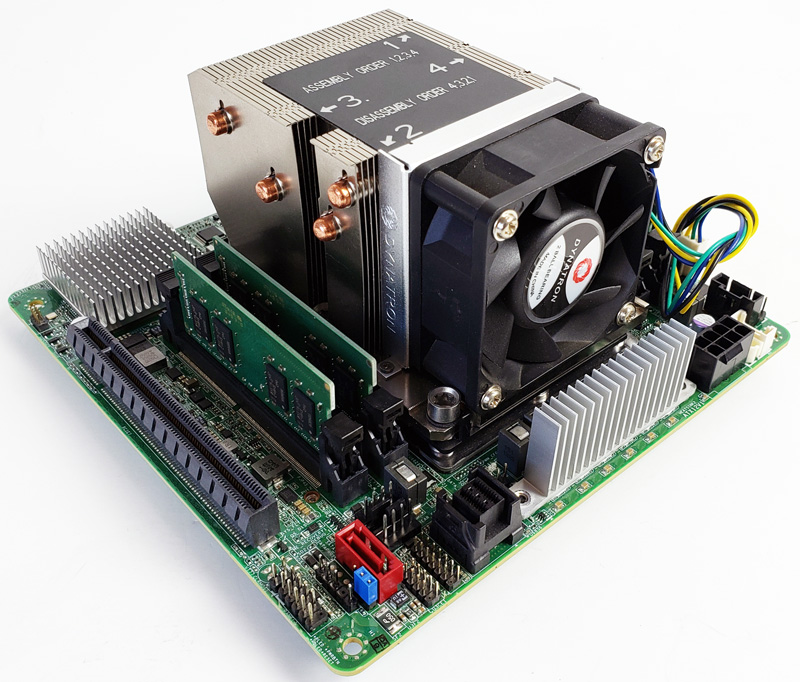
We want to run our SilverStone CS280 NAS headless, the EPC621D41-2M features built-in IPMI and remote access that performs well, in addition, we will use an Intel Xeon Gold 6134 8 core / 16 thread processor and 32GB RAM. We generally would not tell people to use a $2200 CPU in this class of NAS, but we had it on hand so that is what we are using. With the LGA3647 socket, one can scale from 4 to 28 cores if desired.
The space between the power supply and the SATA backplane is very tight, we needed a PSU that allowed enough space to fit the SATA connectors. The power supply we have selected is SilverStone SFX-SX500-G as it fits the SFX PSU requirement.
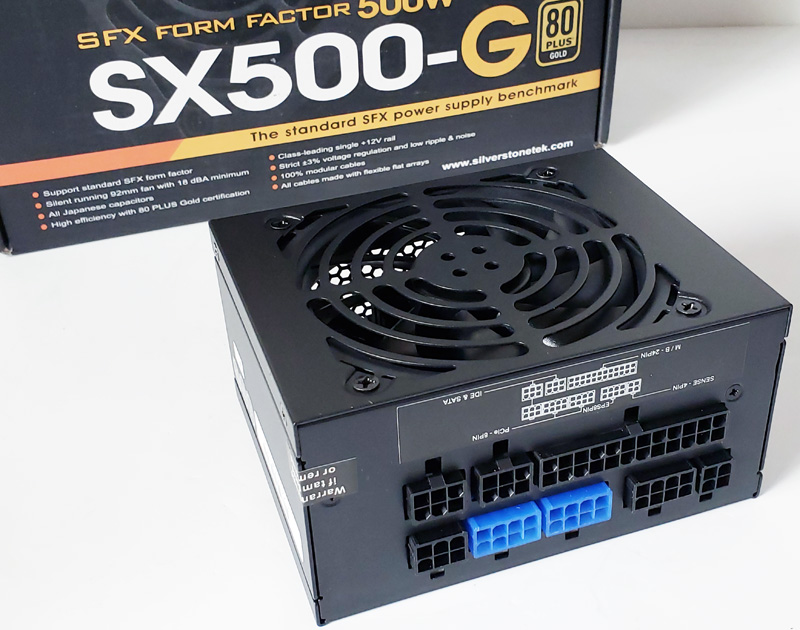
The SFX-SX500-G is a very compact power supply at 125mm (W) x 63.5mm (H) x 100mm (D). In the spec sheet, it is noted that the PSU is black and uses “Lead-Free Paint.” We wonder how many use leaded paint these days.
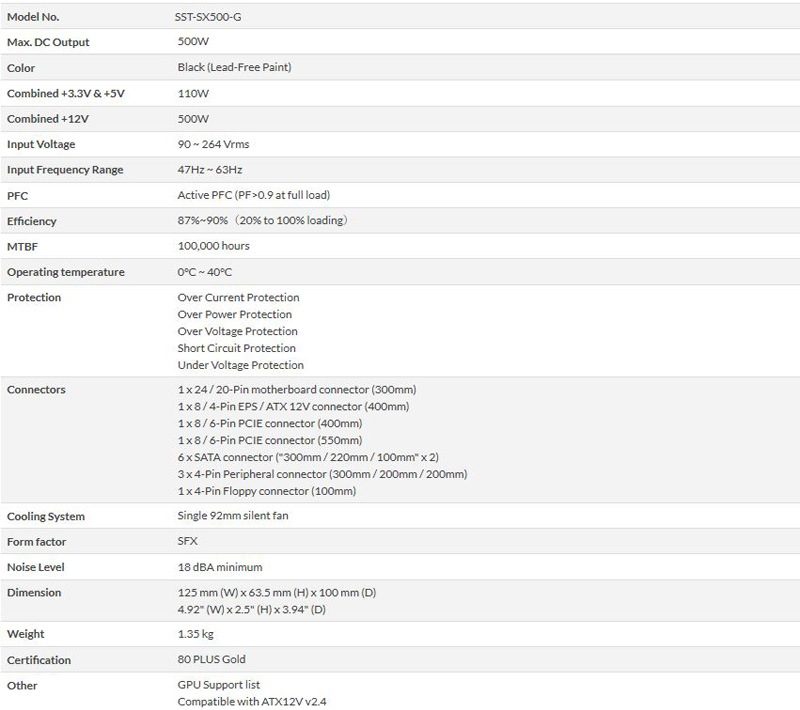
Installing the ASRock Rack EPC621D41-2M system is easy enough with the drive cage removed, we had no issues here.
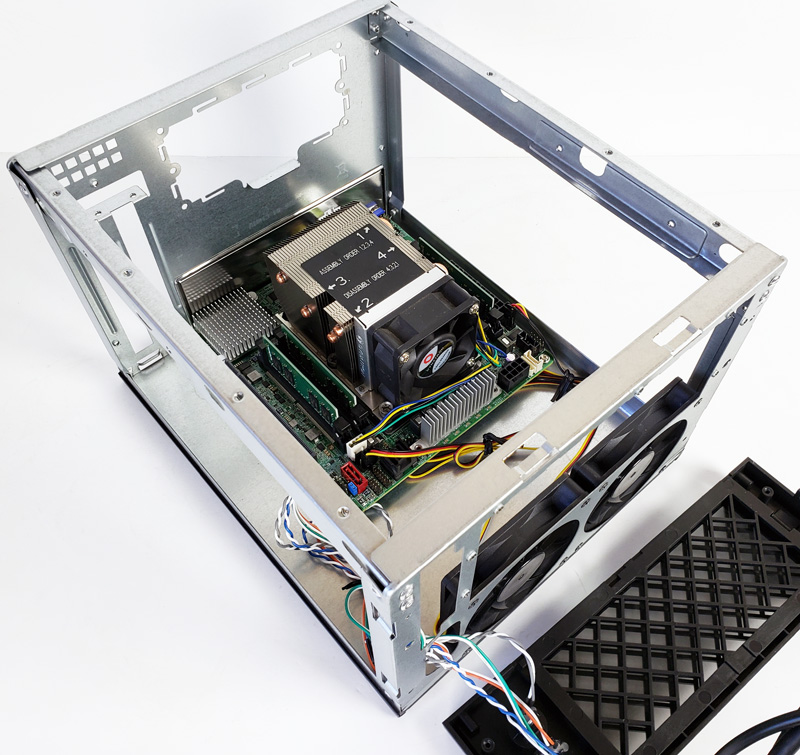
Here we have the SFX-SX500-G power supply installed for a test fitting. For final installation, we rotated the PSU so the cooling fan is facing down. Either position should work fine as there is space above the PSU. With cable management being a challenge with small form factor cases we needed to use the space above the PSU for extra power cables. That is why we rotated the PSU fan facing down.
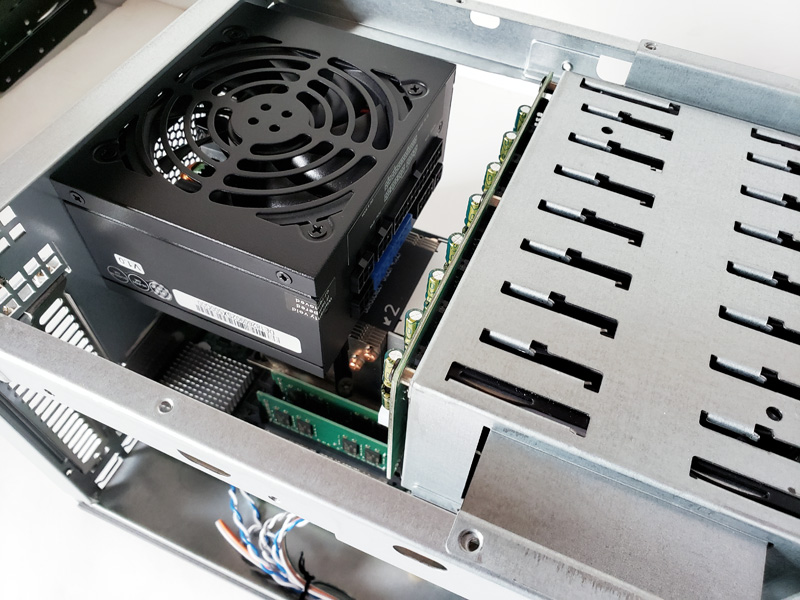
Everything installed fine, with one small exception. We needed to remove the 2.5” SSD cage below the main 8-bay HDD cage to give clearance to the CPU heat sink. SATADOMs and Velcro are good solutions to adding a boot SSD anyway.
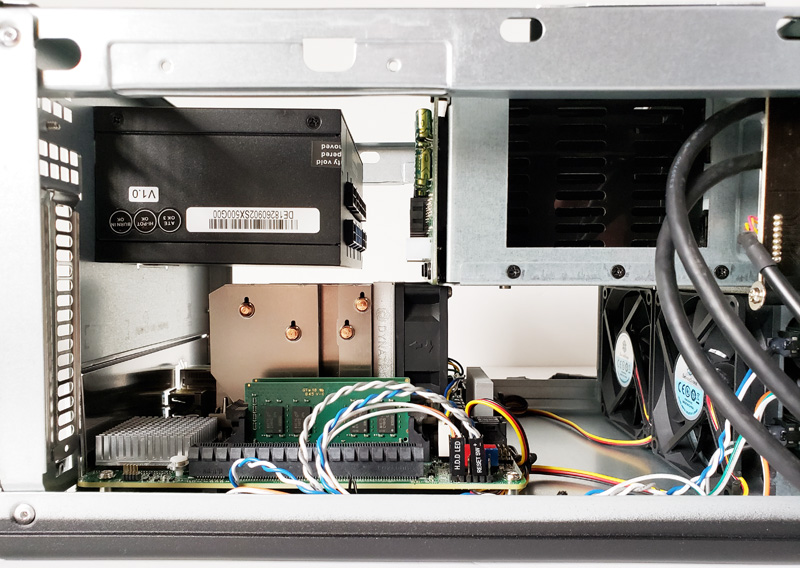
One challenge with the ASRock Rack EPC621D41-2M is it has only one mini-SAS connection on the motherboard for 4-ports. This will work if you only intend to use four SATA SSDs. If all eight are required than a RAID card will need to be installed in the PCIe slot. Many embedded motherboards built for this type of application, such as the Supermicro A2SDi-16C-HLN4F we reviewed, have two SFF-8643 headers natively and do not need the extra PCIe card. They are frankly better fits for this type of chassis.
Space between the PSU and SATA backplane in the SilverStone CS280 is very tight. We only have about one inch to work with. Power supply cables will take up the bulk of the space. We could fit normal SATA cables, but only the first four will fit, instead, we used a set of two HD Mini SAS cables with angled ends, these fit perfectly. We found these on Amazon.
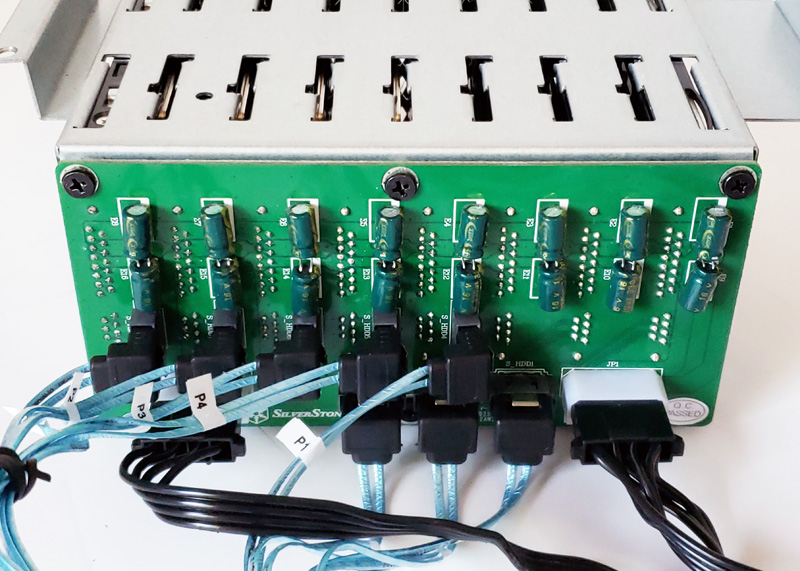
Cable clearance is very tight but everything fits. The fully modular power supply is almost a must here.
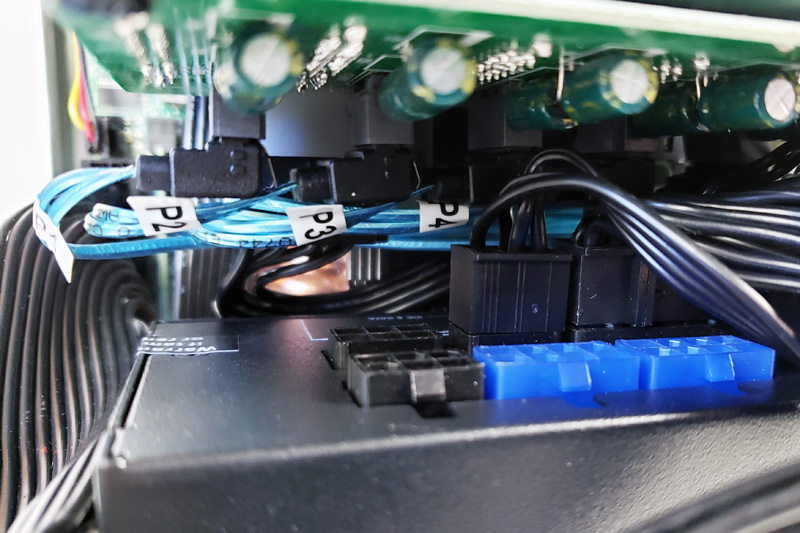
Since we want to use all eight bays we used an LSI / Broadcom SAS 9300-8i RAID controller/ HBA card in the PCIe slot.
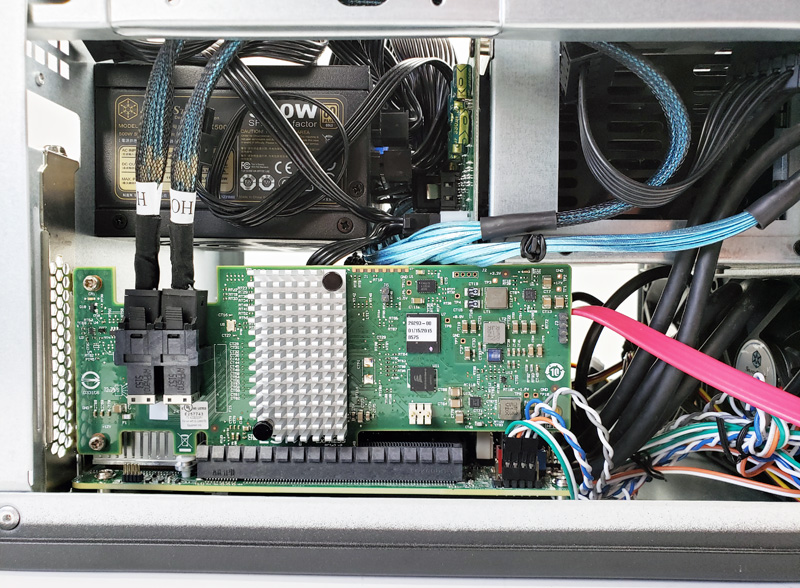
The ASRock Rack EPC621D41-2M motherboard has only 1x PCIe slot on the board. The PCIe slot location falls right under the 8-Bay 2.5” drive cage, our LSI-SAS9300-8i just fits here.
At the time of the build, all our M.2 drives were being used on other projects, the EPC621D41-2M has two M.2 slots on the bottom of the motherboard which would work great for cache or OS drive.
Instead, we used a SilverStone EXB01 2.5” SATA expansion card slot adapter for our SSD OS drive location. The EXB01 is a solid expansion card that included a locking drive door.
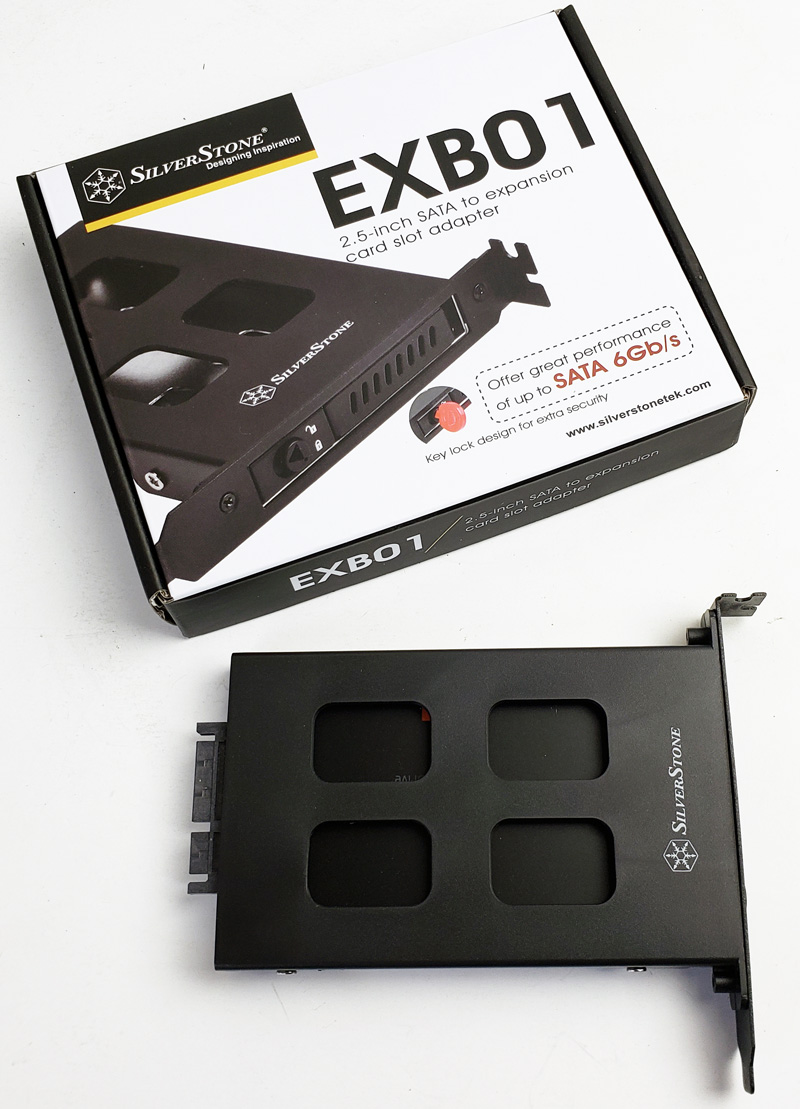
The SilverStone EXB01 uses an empty case PCIe slot location, the CS280 includes two PCIe slots so we had a free slot that could be used for this. It would have been nice if Silverstone included a solution that one could mount either under the 8x drive bay cage or in the PCIe slot making for a more flexible solution.
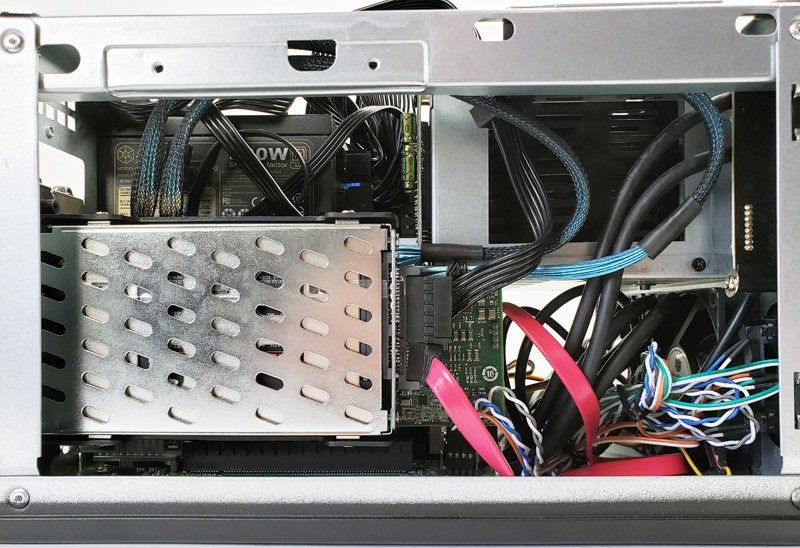
As a note here, cabling is rough. The chassis cables for the front panel connectors, buttons, and LEDs are long. There are 8-9 SATA cables that must be run. One needs two Molex cables for the backplane and an extra SATA power cable here for the OS SSD. We kept these photos without cable management just to show how much is going on. Cable ties can do a lot, but there is a high volume of cables in a small space.
The ASRock Rack EPC621D41-2M motherboard does not include USB 3.0 or audio headers, we will not be using the front USB/ audio ports, the supplied cables were fitted into the empty space at the front of the case.
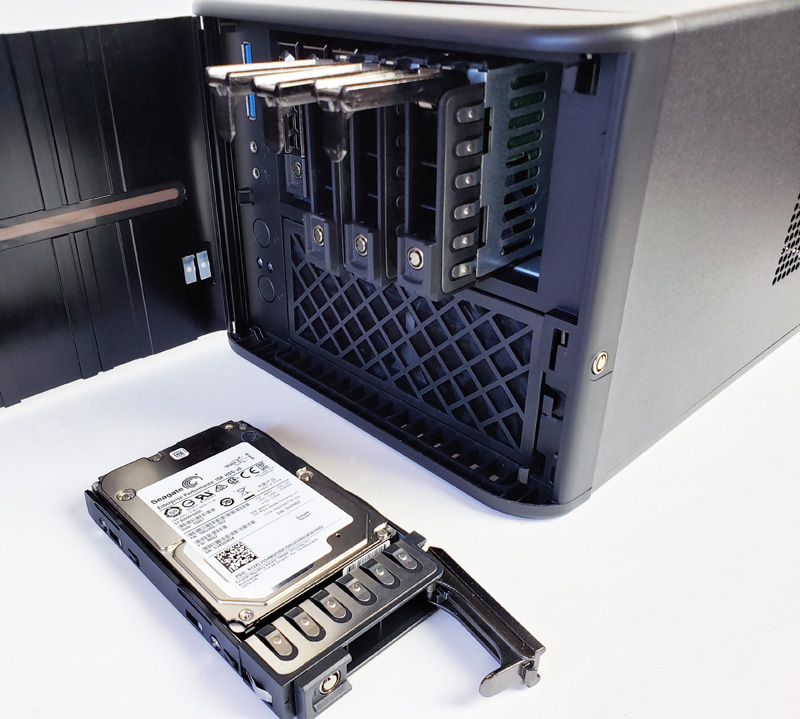
Since we have seen many vendors claim that they have SAS/ SATA backplanes and we have seen them only support SATA, we wanted to test using SAS drives. We are going to test using 2.5″ SAS HDDs. More accurately, we are going to run out benchmarks with four Seagate ST300MP0005 2.5” 300GB SAS hard drives. These are 15K rpm drives so we wanted to stress the chassis cooling, and also validate SAS compatibility. We also had the chance to use eight drives, but we have been doing a 4-bay NAS series and wanted to see how the 15K rpm drives would fare in here.
The drive trays are not toolless and use mounting screws at the sides of the tray. The trays slide in and lock into place.
Now that we have all our components installed and ready to go let’s look at the NAS Configuration and continue on with testing.




LOL… love the overkill! A nice Xeon D system with enough onboard SATA ports & 10 GbE… yeah. I realized SuperMicro offers 2 different PCIe- (2 or 4) NVMe drive cards… that or a video card would be a crazy converged widget. Or… a case like this that could take a FlexATX and you’d get 2 PCIe slots.
If I was ready to abandon 3.5″ drives/jump fully on the 2.5″ drive bandwagon this could be great. At this point I’m not there and I’m still waiting for their latest 8x 3.5″ drive case (CS 381 or something!?) to become available. That one can allegedly take a FlexATX board too…..
> Cable clearance is very tight but everything fits. The fully modular power supply is almost a must here.
This sentence on page 2 followed by a picture that explains very well that fully modular PSUs here are almost a no-go here. It is like the person arranging the pictures for this review strongly disagrees with the opinion of the reviewer here. LOL, it’s just hilarious. Now, look at the picture again and recall what the reviewer wrote on page 1:
> The power caps can be bent around very easily so care should be taken to not break them.
Now look at the clearance between those caps and the modular PSU cables at the photo. LOL, again…
Such compact cases with little space “behind” the PSU are a prime example of the one disadvantage modular PSUs have in such space-constrainted situations: A need for additional space for those plugs there.
A well-chosen non-modular PSU would have avoided modular PSU cables (almost) rubbing shoulders with the SATA connectors and buffer caps. Also note how the SATA backplane is aiding the (potential) use of a non-modular PSU, as it has three of the SATA ports relocated from the area where normally the cables of a non-modular PSU would exit the PSU case.
I am just on page 2 of the review and i already see myself starting to question the reviewers experience with regard to assembling systems and how much thought went into writing the review. Hmm, it almost feels like this review did not just review a Silverstone case, but needed to plug (pun intended) yet another Silverstone product series…
There’s enough room for modular just barely from the pics. I read that part as without modular you’d have too many cables inside so fully modular means you can cut down on cables? That’s reasonable to me. If modular didn’t fit, that’d be a problem. If it fits and cuts down cable clutter, that’s what I’d want.
Great review and build. Counting on STH to always do something over the top like this. Ya’ll rock.
And I’d do modular seeing this too.
@JaredD, you would buy a PSU fitting for the system, not buy a PSU with the mosts cables, no? Why would you think a non-modular PSU has to come with too many cables? There is no logic to this thought.
It fits doesn’t it? I’m totally perplexed. These guys have something that’s actually working and you’re set on some theoretical non-modular PSU that you don’t know if it would actually work. For me, I like examples with pictures of something working. They’ve shown it. You haven’t.
Ah, i see. A believer. “Some theoretical …”, “that you don’t know if it…” “they have shown it”. Well, i guess there is no point continuing…
nice review, but dissapoitting computer case.
2,5 inch hdd space? and….8 sata ports?
why not 3,5 inch hdd? and why not sff-8087 ports?
I had this case and unless they updated it there is really no airflow over the drives. I had 8 4tb 2.5″ spinners in this case and the ones towards the center were getting uncomfortably hot (don’t remember the temp, it’s been a while).
I have this chassis and I’m going to replace the motherboard as I’ve just used a consumer Asrock Z370m-ITX/AC and want one of those Supermicro boards. It really requires some dedication to build this system and one thing that could massively improve the situation for me, is if they could accept two mini-sas connectors and do the breakout on the backplane. But it really is a very nice chassis.
By the time I’m done filling it with 4TB HDDs, I think 4TB SATA SSDs should have dropped to an acceptable level and with 30TB 2.5″ SSDs being a reality already, I think there’s plenty of room for future growth.
Great article!
I’m surprised there’s any airflow over the drives once the front door is closed.
Why isn’t it mesh?
Bán nhà mặt phố Hoàng Hoa Thám, Hà đông, 98
mét vuông, 4 lầu, 9.6 tỷ.